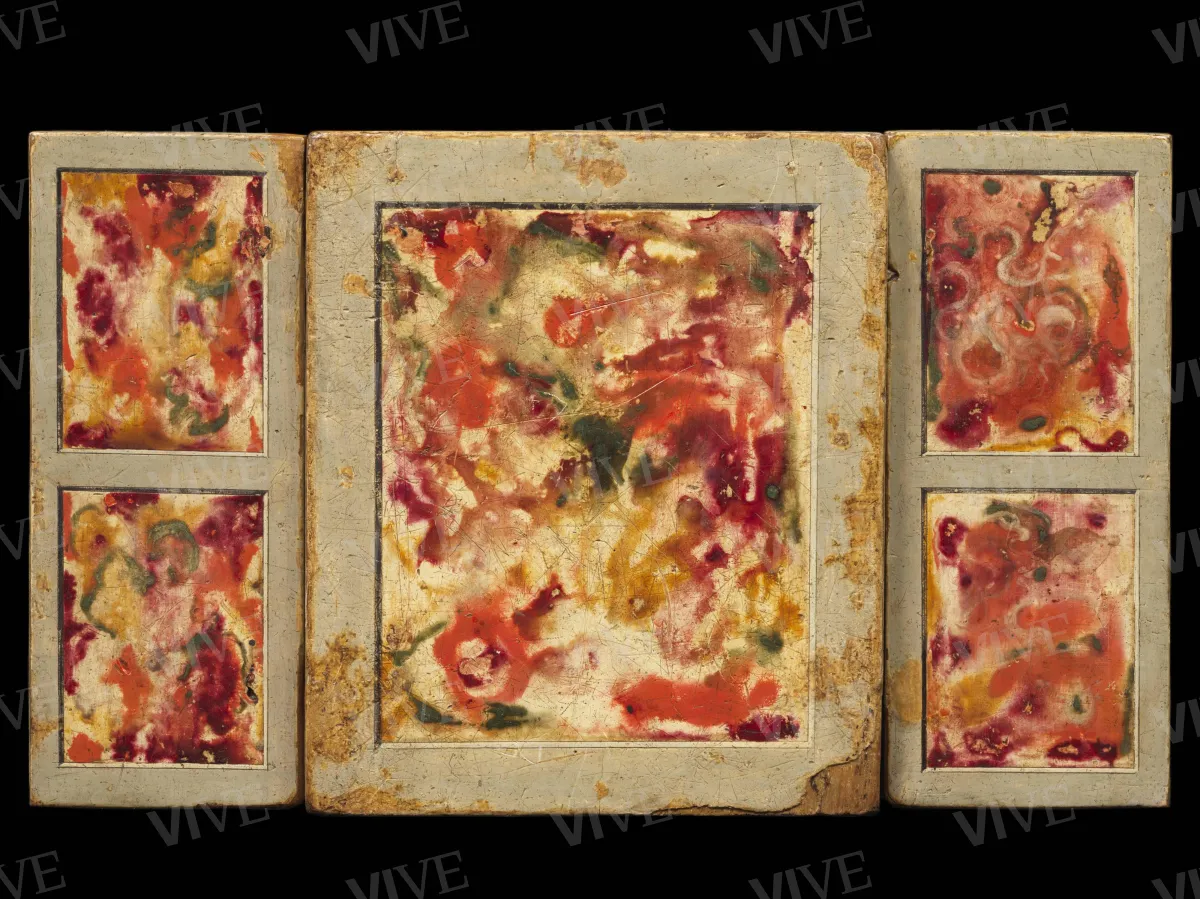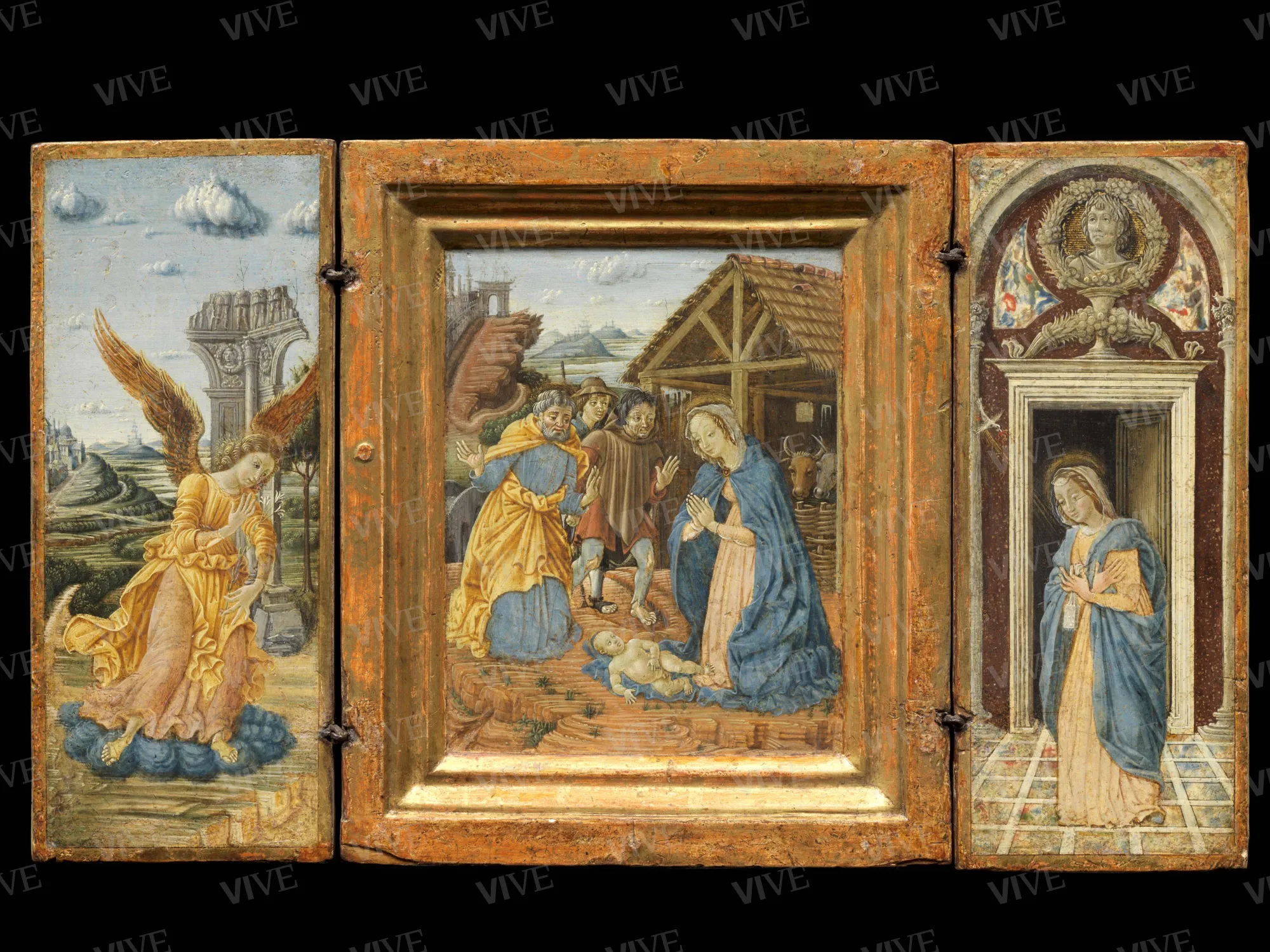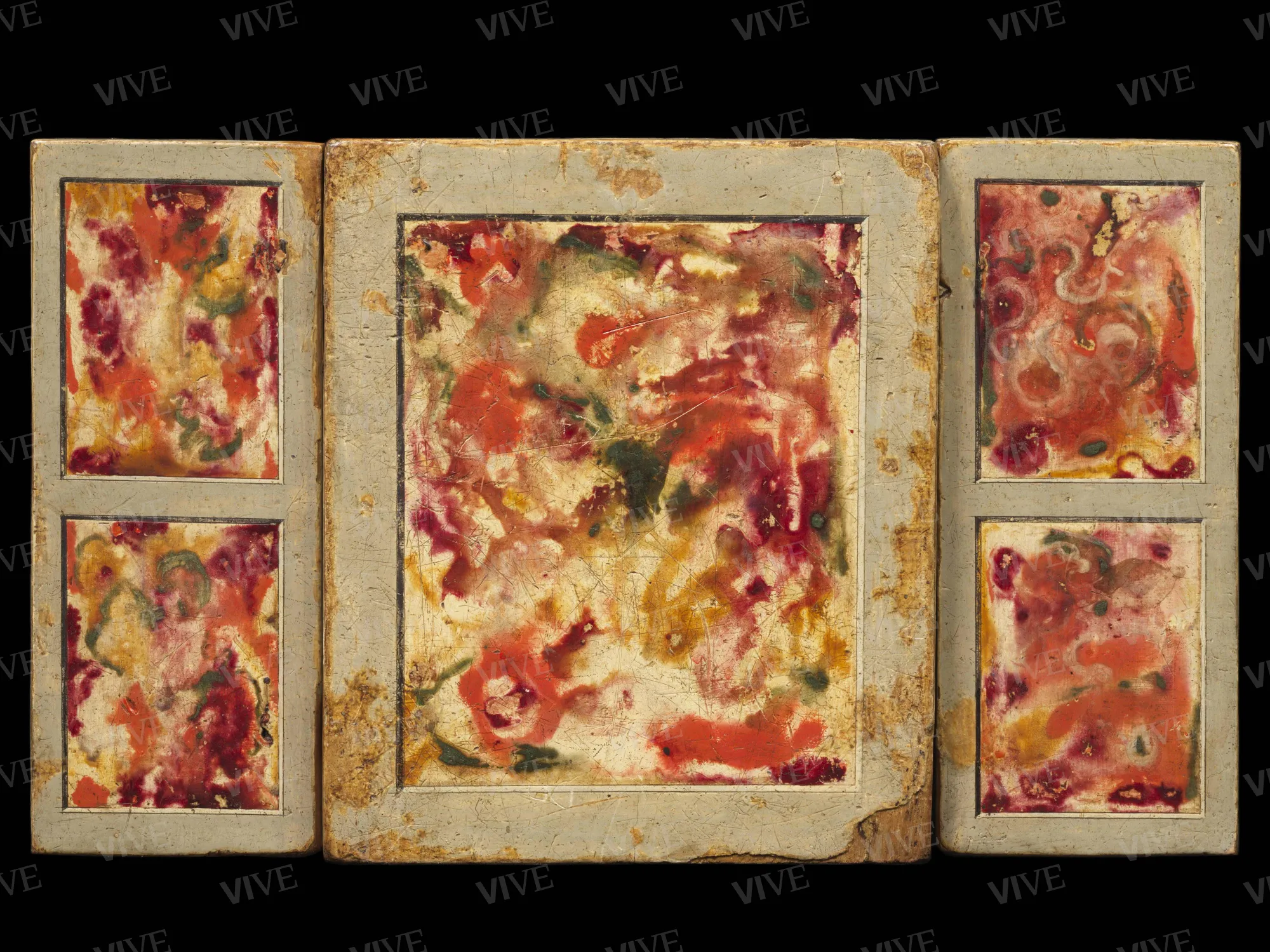Archangel Gabriel; Adoration of the Child; Virgin Annunciate
Northern Italy 1470-1490
The archangel Gabriel is depicted in the left panel of the triptych, set against a landscape backdrop with a towering ruined triumphal arch. This same ancient culture is evident in the space housing the Virgin Annunciate in the right panel and in the colored faux marble decoration on the reverse of the panels. The central panel, featuring the Adoration of the Child, draws inspiration from Mantegna. The small size and precise micrographical execution suggest that the work can be attributed to an illuminator active in northern Italy during the 1470s and 1480s.
The archangel Gabriel is depicted in the left panel of the triptych, set against a landscape backdrop with a towering ruined triumphal arch. This same ancient culture is evident in the space housing the Virgin Annunciate in the right panel and in the colored faux marble decoration on the reverse of the panels. The central panel, featuring the Adoration of the Child, draws inspiration from Mantegna. The small size and precise micrographical execution suggest that the work can be attributed to an illuminator active in northern Italy during the 1470s and 1480s.
Details of work
Catalog entry
The intricate critical history of this small portable altarpiece, intended for private devotion, underscores the significant challenges in identifying the cultural influences of its author. Pietro Toesca first evaluated the triptych (1906, p. 377), while it was part of the diverse collections at the Kircherian Museum, attributing it to a “miniaturist from northern Italy.” Antonino Santangelo (1947, p. 23) later refuted this assessment, proposing instead that it was the work of Girolamo da Cremona, drawing comparisons with the latter’s early miniatures in the Missal of Barbara of Brandenburg—possibly influenced by Federico Zeri, who referenced the triptych in a letter to Roberto Longhi (February 9, 1948, Natale 2021, p. 199, no. 67).
Zeri himself, in the Catalogo del Gabinetto Fotografico Nazionale (1955, p. 10, no. 147), initially ascribed the work to an anonymous master of the Lombardy–Veneto school active in the latter half of the fifteenth century. However, he later revised his position in a handwritten note on the reverse of his own photograph of the piece (preserved in the photo library of the Fondazione Zeri in Bologna, file no. 28076), reinstating Santangelo’s attribution to Girolamo da Cremona and noting: “juvenile – see Missal of Barbara of Brandenburg / nothing to do with the Madonna di Perugia.”
Meanwhile, Mario Salmi (1954, pp. 131–132) had also favored a nonspecific attribution to an “anonymous Paduan,” and at the Mostra storica nazionale della miniatura (1953), the altarpiece was attributed to an unknown follower of Mantegna, capturing the distinctive temperament that informs the work.
Maurizio Bonicatti (1964, pp. 42, 47, 179) suggested that the triptych should be attributed to Giovanni Corenti, rather than Girolamo da Cremona, noting influences from Mantegna, Veronese, and Ferrara–Padua, similar to Bernardino da Parenzo’s style around 1490.
Reviving a proposal originally made by Berenson (1968, I, p. 135), who attributed the altarpiece to Fiorenzo di Lorenzo of Perugia, Luisa Morozzi (2001) tentatively assigned it to an anonymous Umbrian painter from the 1480s. She posited that the influence of Mantegna’s models is mediated through central Italian figurative culture. However, comparisons between the triptych in Palazzo Venezia and the Madonna and Child with Angels (Perugia, Galleria Nazionale dell’Umbria)—previously attributed to Fiorenzo di Lorenzo, then Bartolomeo Caporali, and even Girolamo da Cremona—are not entirely compelling. Alessandro Angelini has spoken of a possible origin in the Marches region for the altarpiece, suggesting it represents a pinnacle of Adriatic Squarcionism, possibly connected to Nicola di Maestro Antonio of Ancona.
In this portable altarpiece, the most evident and significant cultural reference is the influence of Mantegna, particularly his Adoration of the Shepherds, c. 1455–1456 (New York, Metropolitan Museum of Art; see specific entry in De Marchi 2008). This work is indisputably the model for the central compartment of the triptych depicting the same subject. The landscape behind the shepherds in the Adoration and the archangel Gabriel in the left panel are distinctly Mantegnaesque. Additionally, the Madonna’s room features old-style ornaments reminiscent of the Bridal Chamber.
A detail of the Adoration in the small triptych, where the tile has slipped from the ridge of the roof of the hut, is found in a miniature by Guglielmo Giraldi (in Candido Bontempi, Libro del Salvatore, 1469–1471, Modena, Biblioteca Estense Universitaria, inv. alfa T.5.27 = Ital. 353). Similar types of huts can also be found in miniatures by Giovanni Vendramin. Additionally, the unique binding—known as a “pouch binding”—of the small volume held by the Virgin Annunciate in the right panel appears to indicate a common practice with books (according to Federica Toniolo, communicated in private conversation).
These references draw us into the realm of miniature art, which is also aligned with the small scale of the work, reflecting back to Girolamo da Cremona and the insights of Santangelo and Zeri. Notably, there is a resemblance to certain pieces by the Veronese artist Francesco dai Libri, specifically those dated between the late 1470s and early 1480s, such as the Adoration of the Magi (Paris, Musée Marmottan, Wildenstein collection) and the Pietà from the Cleveland Museum of Art. Francesco, a miniaturist deeply influenced by Mantegna, portrayed themes with a more intimate, secular humanity and incorporated elements from the Ferrara and Verona schools of miniature, including works by Liberale da Verona and Girolamo da Cremona. However, there are insufficient elements to indisputably attribute this work to him. Therefore, it is prudent to posit a cautious reference to the school of Mantegna and assign it to a date between the 1570s and 1580s.
Francesco Guidi
Entry published on 27 March 2025
State of conservation
Fair.
Restorations and analyses
Istituto Centrale per il Restauro, 1945;
Aldo Angelini, March 1974.
Provenance
Rome, Museo Kircheriano, at least until 1906;
Rome, Museo Nazionale di Castel Sant’Angelo (?);
Rome, Museo Nazionale di Palazzo Venezia, 1920.
Exhibition history
Rome, Museo Nazionale del Palazzo di Venezia, Mostra storica nazionale della miniatura, 1953;
Rome, Museo Nazionale del Palazzo di Venezia, Athanasius Kircher. Il museo del mondo, February 28–April 22, 2001.
References
Toesca Pietro, Dipinti nella Galleria Estense di Modena e nel Museo Kircheriano di Roma, in «L’Arte», IX, 1906, pp. 373-377;
Santangelo Antonino (a cura di), Museo di Palazzo Venezia. Catalogo. 1. Dipinti, Roma 1947, p. 23;
Muzzioli Giovanni (a cura di), Mostra storica nazionale della miniatura, catalogo della mostra (Roma, Palazzo di Venezia, 1953), Firenze 1953, pp. 492-493, n. L bis;
Salmi Mario, Aspetti della cultura figurativa di Padova e di Ferrara nella miniatura del primo Rinascimento, in «Arte veneta», VIII, 1954, pp. 131-141;
Zeri Federico (a cura di), Catalogo del Gabinetto Fotografico Nazionale. 3. I dipinti del Museo di Palazzo Venezia in Roma, Roma 1955, p. 10, n. 147;
Bonicatti Maurizio, Aspetti dell’umanesimo nella pittura veneta dal 1455 al 1515, Roma 1964, pp. 42, 47, 179, fig. 49;
Berenson Bernard, Italian Pictures of the Renaissance. Central and North Italian Schools, London 1968, I, p. 135;
Todini Filippo, Agostino Mariotti: un collezionista nella Roma settecentesca, in «Antologia di Belle Arti», IV, 13/14, 1980, pp. 27-37, nota 32;
Morozzi, in Lo Sardo Eugenio (a cura di), Athanasius Kircher. Il museo del mondo, catalogo della mostra (Roma, Museo Nazionale del Palazzo di Venezia, 28 febbraio-22 aprile 2001), Roma 2001, pp. 292-294, n. VI.2;
De Marchi, in Agosti Giovanni, Thiebaut Dominique (a cura di), Mantegna 1431-1506, catalogo della mostra (Parigi, Musée du Louvre, 26 settembre 2008-5 gennaio 2009), Milano 2008, pp. 160-161, n. 50;
Natale Mauro (a cura di), Federico Zeri-Roberto Longhi. Lettere (1946-1965), Milano 2021, p. 199, n. 67.














